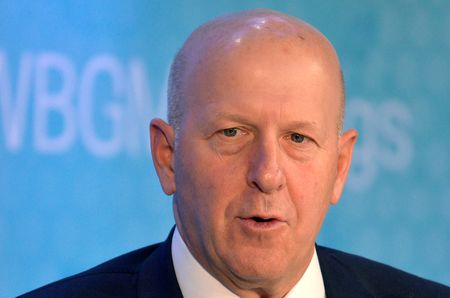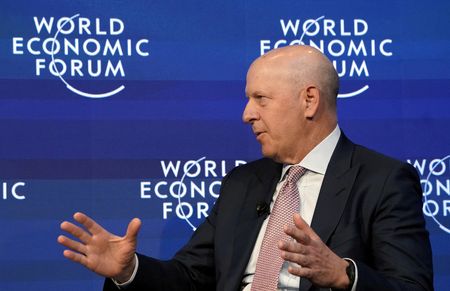


By Matt Scuffham
NEW YORK (Reuters) – Goldman Sachs will on Thursday update its main financial targets and detail growth plans for the next three to five years, hoping to win over investors yet to be convinced by its long-term strategy.
Wall Street’s premier investment bank is reshaping itself after a turbulent decade during which profit at its core trading businesses was crimped by tougher regulations brought in after the 2007-09 financial crisis.
The firm plans to upgrade some existing targets and add new ones, people familiar with the plan say. Key profitability targets will be lifted and new goals set for the growth of the bank’s nascent consumer business. Reuters reported on the upcoming targets in December.
The bank achieved a record profit last year, helped by a deal making and trading bonanza fueled partly by the Federal Reserve pumping liquidity into capital markets to mitigate the impact of the COVID-19 pandemic.
The favorable market backdrop has helped Goldman track ahead of key goals set at its first-ever investor day in January 2020. At that time, Chief Executive David Solomon set out his vision for rejuvenating a bank which had underperformed rivals since the 2007-09 financial crisis.
The initial plan aimed to diversify Goldman into businesses with more predictable revenue streams, such as consumer and transaction banking, and reshape its trading and investment banking businesses to produce more consistent revenues.
Two years on from investor day, Solomon will look to build on those foundations when he provides an update on the firm’s strategy and goals at a conference hosted by Credit Suisse in Florida, people familiar with the matter say.
Goldman Sachs declined to comment.
The presentation comes at a critical time. The value of the bank’s shares more than tripled between the start of the pandemic in March 2020, hitting an all-time high on August 27 2021. However, they have declined by 14% since as analysts questioned how the business will perform when market conditions normalize. Rival Morgan Stanley is down 4% in that period while JPMorgan is down 5%.
Goldman’s shares currently trade at 1.3 times the value of the bank’s assets while Morgan Stanley, traditionally its biggest rival, trades at close to 2 times its book value.
That leaves Solomon facing a battle to convince investors his strategy will lead to a re-rating over time.
“Morgan Stanley’s well-diversified and proven business lines put it way ahead of Goldman’s work-in-process diversification plays in consumer finance, credit cards, wholesale lending and payments,” said David Hendler, founder of Viola Risk Advisers.
The bank will set new medium term return-on-equity (RoE) and return-on-tangible-equity (RoTE) targets of at least 15%, compared with the previous goals of 13% and 14% respectively, Reuters reported in December.
Goldman will outline new growth targets for its consumer business, people familiar with the matter say. However, it will no longer set a target for when that business will break even. Instead, it is focusing on generating top-line growth.
The consumer business, named Marcus after the bank’s founder, launched in 2016. It was originally expected to make a profit in 2021, but the cost of investing in new products and acquisitions have pushed that timing back.
In an effort to accelerate the growth of its consumer business, Goldman purchased GreenSky, a fintech platform that provides home improvement loans, last September in a $2.2 billion deal. It is also investing in the launch of a Marcus checking account later this year.
The bank is also trying to make its core trading and investment banking revenues more durable.
In trading, it is doing more business with the top 100 institutional clients globally. That has helped it pick up market share which executives are confident it will hold on to.
In investment banking, Goldman has added to its additional strength in advising blue-chip companies on deals by taking a bigger market share advising mid-market companies.
The bank has also grown its asset management and wealth management businesses.
Those initiatives justify the bank raising its medium-term RoTE target despite trading and investment banking activity slowing, people within the bank say.
(This story has been refiled to correct date in dateline)
(Reporting by Matt Scuffham; editing by Megan Davies and Nick Zieminski)

